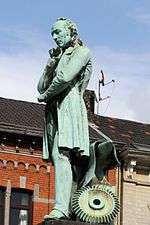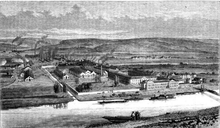John Cockerill (company)
|
Poster for the SA Cockrill, 1928 | |
| Industry | Integrated steel and manufacturing |
|---|---|
| Successor |
SA Cockerill-Ougree ultimately : ArcelorMittal Liège also, mechamical engineering division : Cockerill Maintenance & Ingénierie |
| Founded | 1917 |
| Founder | John Cockerill, Charles James Cockerill |
| Headquarters | Seraing, Belgium |
The John Cockerill Company was a Belgian iron, steel, and manufacturing company based in Seraing in the region of Liège. It was founded in 1825 by British industrialist William Cockerill and his family.
John Cockerill, son of William Cockerill owned the company, and it was known as John Cockerill & Cie. John Cockerill died in Warsaw in 1840 after a business trip to Russia. He had made the trip to raise funds to save the company from bankruptcy. But after his death the company became state owned, and in 1842 it became known as Société anonyme pour l'Exploitation des Etablissements John Cockerill.[note 1]
The company was one of the major iron and steel producers in western Europe throughout its existence. It was a major producer of derived products, including rail and railway locomotives, iron production equipment, and other large-scale iron and steel constructions.
In 1955 it merged with Ougrée-Marihaye to form SA Cockerill-Ougrée. And in 1981 it merged into Cockerill-Sambre.
History
John Cockerill & Cie (-1842)

In 1799 the British-born blacksmith and mechanical engineer William Cockerill set up a textile machinery factory in Verviers, Belgium. In 1807 he moved to Liège and created a factory that constructed machinery for the carding, spinning and weaving of wool,[1] as well as steam engines.[2] His family from England joined him, and his sons, John and Charles James, managed the factory in Liège.[3] After purchasing the former palace of the Prince-Bishopric of Liège at Seraing, Charles James and John constructed an iron foundry and machine building factory.[3] there. From its inception in 1817, the complex in the Liege region expanded under the control of the Cockerill, with a coke-fired blast furnace and manufacturing facilities for steam engines, railway locomotives, steam-powered blowers for blast furnaces, and traction engines.[4] John Cockerill's business interests also expanded to include coal mining and collierys.[5] The company rose to be the primary steel company of Europe, spurred on by its involvement in the construction of the Belgian railways.[6]
William retired in 1813, and his son John took over the company;[5] and in 1825 itcbecame known as John Cockerill & Cie.[2] In 1839 a banking crisis hit Belgium, and John Cockerill's company became bankrupt as a result.[7] In 1840 he traveled to Russia in an attempt to raise funds for the company, but he died of typhus on the trip home, leaving no direct heir.[3] Faced with the prospect of closing an enterprise that employed 30,000, the state bought the assets, and on 20 March 1842, the company became known as Société anonyme pour l'Exploitation des Etablissements John Cockerill.[6] (SA John Cockerill)[note 1]
Société anonyme John Cockerill (1842-1955)

Under state control, the company expanded further. In 1865 when the plant at Seraing was visited by a mission from Japan, it was 192 acres (780,000 m2) in size and had two coal mines, as well as facilities for the manipulation of iron and steel, with boiler and locomotive works.[2] A bessemer converter had been installed in 1863, and the company expanded into the production of transatlantic ships and bridges,[8] ironclads, and tunneling machines.[9]
In 1866 the company's director, Eugene Sadoine, began an expansion of the company's mining assets; developing nearby coal mines in Colard and iron mines in Spain.[9] By 1872 the company's first Siemens-Martin converter began operation, and in 1886 it began to use the Gilchrist-Thomas process (basic process).[10]
In 1945 the company took over SA Angleur-Athus, and in 1955 SA John Cockerill merged with SA Ougrée-Marihaye to form SA Cockerill-Ougrée.[11]
1955 to present
The company Cockerill-Ougrée underwent further mergers as the Belgian steel industry was consolidated in the second half of the 20th century, becoming Cockerill-Ougrée-Providence in 1966, Cockerill-Ougrée-Providence et Espérance Longdoz in 1970; the name was shortened to Cockerill. In 1980 merger with Hainaut-Sambre produced Cockerill-Sambre, which through further mergers then became part of Usinor in 1999, Arcelor in 2002, and then part of ArcelorMittal in 2008.
The mechanical engineering part of the Cockerill, which distinguished itself from other Belgian steelmakers, became a separate company in 2002 when it was purchased from Usinor by a private consortium. As of 2010 the company operates as Cockerill Maintenance & Ingénierie (CMI) (previously Cockerill Mechanical Industries) and produces a range of products, including boilers, shunting locomotives, steel mill and other large-scale industrial equipment, and military equipment.[12]
As of 2010 steel production in Seraing continued under the name ArcelorMittal Liège, producing flat carbon steel with processes from coking and blast furnace production of steel and continuous casting and hot rolling to coating of steel with zinc or plastic.[13]
In 2011 all liquid steel production in the ArcelorMittal Liege division was ended, resulting in protests, strikes, and the temporary kidnapping of several ArcellorMittal executives as protest against the closure. The company cited overcapacity and uncompetitiveness as reasons for the closure. However, a report by Syndex commissioned by trade unions contradicted the claims of un-competitiveness, claiming ArcelorMittal's reports had used biased accounting. Union officials called for the liégeois steel industry to be taken into ownership outside ArcellorMittal to protect it.[14]
See also
Notes
- 1 2 Also written as Société anonyme John Cockerill, or SA John Cockerill. In English either often referred to as the "John Cockerill Company".
References
- ↑ Lance Day; Ian McNeil (2003). Biographical Dictionary of the History of Technology. books.google.co.uk. Routledge. Cockerill, William , pp.280-281.
- 1 2 3 Ian Hill Nish (1998). The Iwakura mission in America and Europe: a new assessment. Routledge. pp. 103–5.
- 1 2 3
 Stephen, Leslie, ed. (1887). "Cockerill, William". Dictionary of National Biography. 11. London: Smith, Elder & Co. p. 200.
Stephen, Leslie, ed. (1887). "Cockerill, William". Dictionary of National Biography. 11. London: Smith, Elder & Co. p. 200. - ↑ Albert Gieseler. "Société Anonyme John Cockerill". www.abert-gieseler.de (in German).
- 1 2 Robert Chambers; William Chambers (1840). "The Cockerills". Chambers's Edinburgh journal. W. Orr. 8: 165–166.
- 1 2 Caractéristiques des bassins industriels dans l’Eurégio Meuse-Rhin, b.1. Le bassin houiller et sidérurgique de Liège
- ↑ Erik Buyst and Ivo Maes. "Central banking in 19th-century Belgium: was the NBB a lender of last resort?" (PDF). economix.u-paris10.fr. 3.1. The crisis of 1838: the government comes to the rescue, pp.8-10.
- ↑ Caractéristiques des bassins industriels dans l’Eurégio Meuse-Rhin, 2.c. Le défi de l'acier et les premières fusions
- 1 2 "Cockerill Sambre Group -- Company History". www.fundinguniverse.com.
- ↑ Adriaan Linters (1986). Industria: architecture industrielle en Belgique. books.google.co.uk (in French, Dutch, and English). Mauad Editora Ltda. p. 32.
- ↑ Caractéristiques des bassins industriels dans l’Eurégio Meuse-Rhin, 2.d. L'indispensable restructuration
- ↑ "CMI: Cockerill Maintenance & Ingénierie". www.cmigroupe.com.
- ↑ "ArcelorMittal Liège". www.cockerill-sambre.com (in French). Archived from the original on 16 June 2011.
- ↑ Sources:
- "10 000 manifestants sur la place communale de Seraing", www.rtbf.be (in French), 26 October 2011
- "ArcelorMittal : " Le combat est le même pour tous "", www.lesoir.be (in French), 26 October 2011
- ArcelorMittal confirms closures at Liège site, 14 October 2011
- Silvia Antonioli; Robert-January Bartunek (5 October 2011), "ArcelorMittal executives held in Belgian protest freed", www.reuters.com
- "ArcelorMittal bosses freed after Belgian protest", www.euronews.com, 5 October 2011
- "ArcelorMittall : les justifications de la fermeture liégeoise ne tiennent pas, selon le rapport Syndex", www.rtbf.be (in French), 8 March 2012
Sources
- Suzanne Pasleau (2002-3). "Caractéristiques des bassins industriels dans l'Eurégio Meuse-Rhin". Fédéralisme Régionalisme (in French). 3. Check date values in:
|date=(help)
Further reading
- John P. McKay (1970). "9. A Pioneering Innovator : The John Cockerill Company in Southern Russia 1885-1905". Pioneers for profit; foreign entrepreneurship and Russian industrialization, 1885-1913. University of Chicago Press.
External links
| Wikimedia Commons has media related to John Cockerill (company). |
- 50°36′25″N 5°30′20″E / 50.606904°N 5.505577°E, Seraing steelworks